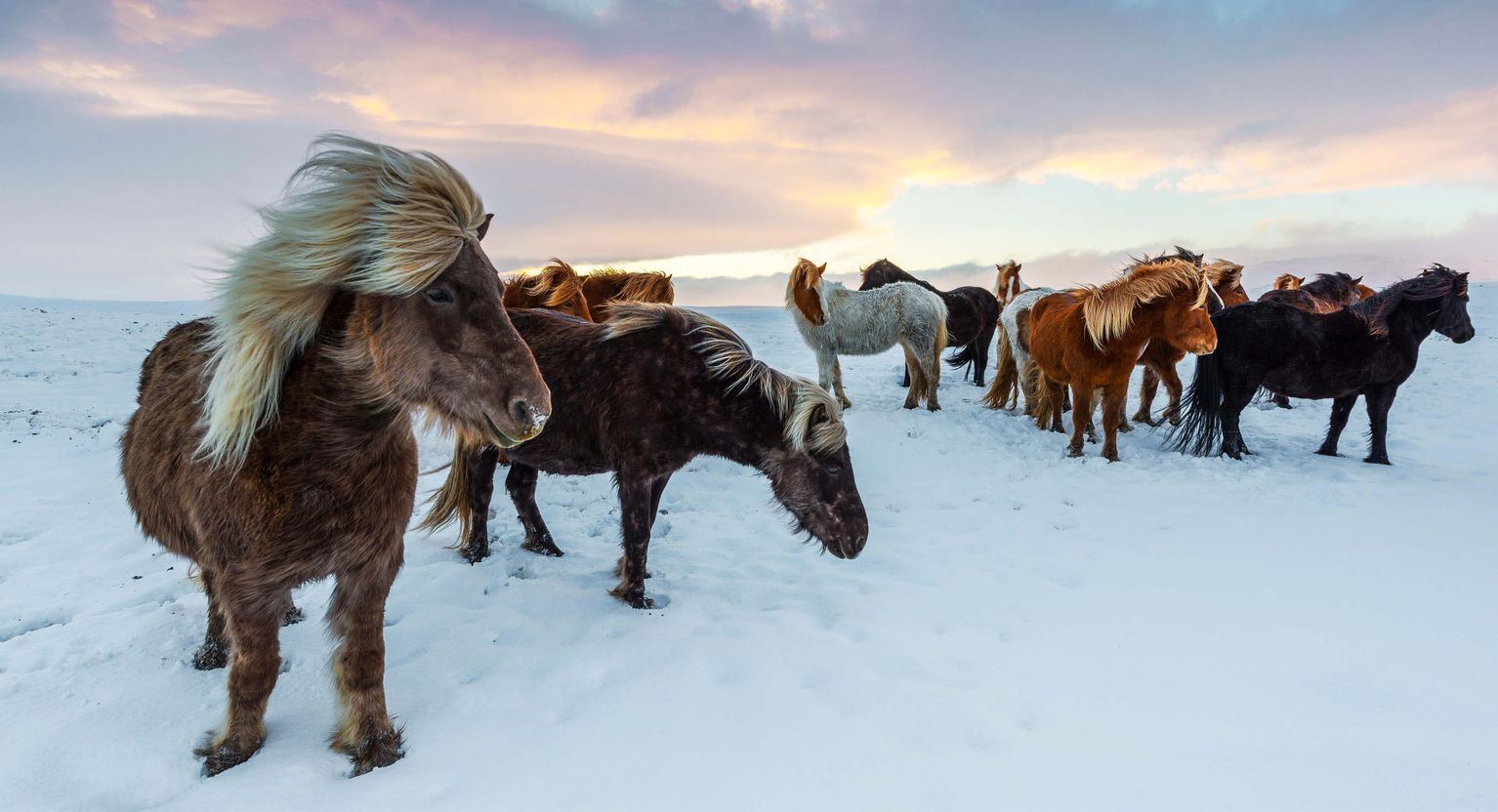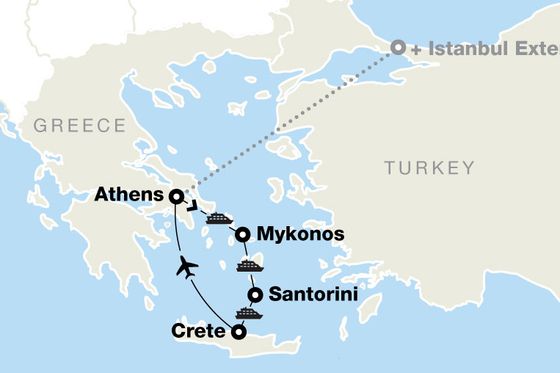
10 things you can only do in Iceland during the winter
From horseback rides through the snow to guided tours through ice caves, here are 10 of the top things to do in Iceland in the winter.
Winter in Iceland is pure magic. The Land of Fire and Ice is home to steamy geothermal pools, towering glaciers, and nature’s most spectacular show: the northern lights. There is no better time to experience these natural wonders than during the winter.
Snow and ice create dreamlike landscapes. Roaring waterfalls freeze into icicles. Holiday traditions and celebrations create camaraderie between locals and visitors, and a whole new world of outdoor adventure—from horseback rides through the snow to guided tours through ice caves. Read on for 10 of the top things to do in Iceland in the winter.

1. Watch the dance of the northern lights
“I went to Iceland in January and saw the most beautiful display of northern lights dancing across the sky,” said staffer Bridget. “It really does look like they’re dancing! Our tour guide said it was the best display he’d seen in the last five years—absolutely worth the colder weather.”
Watching the magical northern lights spread their amazing colors across a deep, dark winter sky is breathtaking and tops many a traveler’s bucket list. While catching the show is never guaranteed (Mother Nature is fickle!), Iceland’s long winter nights and dark skies offer you the best chance to witness them. Experienced local guides know the best times and places to take in the otherworldly experience of the aurora borealis. And when the magic happens, it’s everything you hoped for.
As staffer Whitney recalls of her Iceland: Reykjavik & the Northern Lights tour, “I came to Iceland to experience the thrill of chasing the northern lights, and truly felt like I was chasing the weather,” she said. “The last night, there they were. I still can’t believe what I saw, and it is a memory I will cherish for a lifetime.”
2. Experience the fantastical insides of a glacier
“The best thing I did in Iceland was visit the ice caves!” said staffer Ari. “There’s something super magical and beautiful about being in an ice cavern!”
Beyond the beauty of the aurora borealis, one of the most interesting things to do in Iceland during the winter is to tour a natural ice cave. These mesmerizing ice caves form naturally each winter and melt each summer, creating unique structures each year. The shimmering blue ice formations inside the caves mimic the underwater beauty of the oceans. It’s not to be missed!
On our Iceland: Reykjavik & the Northern Lights tour you can add the extension to West Iceland, where you’ll travel to Langjökull Glacier in a specially modified snow truck (the ride through the snow is almost as thrilling as the walk through the caves!). “The 30-to-40-minute drive to get out to the glacier tunnel is one of the most breathtaking things I have ever seen,” said traveler David. “Pristine landscape covered with pure white snow that has not been touched by humans or wildlife for as far as the eye can see—wow.”

3. Be dazzled by snow-covered, frozen waterfalls
“Iceland is famous for its beautiful waterfalls,” said staffer Lindsay. “Seeing them caked in thick snow is a treat—not to mention a dramatic sight—in the wintertime. In fact, snow makes Iceland’s already otherworldly scenery seem even more moody and spectacular.”
There seem to be more waterfalls in Iceland than you can count, thousands in all! Although these roaring cascades dazzle all year, Iceland’s waterfalls never look more dreamlike than they do in the winter. Blanketed with snow and coated with ice, they sparkle and shimmer like jewels in a winter wonderland. While some are so powerful that they don’t freeze, those that do sometimes reward visitors with views of icicles that hang like frosted stalactites.
One of the best waterfalls to view during winter in Iceland is Gullfoss in the Golden Circle. It’s among the country’s largest and most powerful waterfalls. (You won’t need to get too close to enjoy the views.) Horseshoe-shaped Goðafoss (which translates to Waterfall of the Gods) also looks its best in the wintertime.
4. Explore the Christmas markets of Reykjavik
Though Iceland has a long pagan tradition (thanks to its Viking roots), Christmas is a big deal these days. And nowhere more so than in Reykjavik, which is quickly becoming a favored international Christmas destination. In late November, locals light the Oslo Christmas Tree to mark the start of the holiday season. It seems the entire city comes out for the lighting! The month of December is the perfect time to explore the city’s festive Christmas markets.
You’ll want to meander through The Christmas Market at Hjartagarðurinn to get your fill of holiday spirit, along with Christmas cookies, hot chocolate, handmade products, and their celebrated mulled wine. Head to Ingólfur Square in downtown Reykjavik where you’ll find another Christmas market, plus an ice skating rink where you can rent skates and glide across the ice for free under the Christmas lights.

5. Celebrate New Year’s Eve at a community bonfire
“Catch one of the bonfires on New Year’s Eve,” said staffer Nicole. “It’s a winter tradition where locals and visitors gather to celebrate before the clock strikes midnight and sing Icelandic folk songs, and they have several all over the city. You can watch the incredible fireworks displays, too. It was a magical night. We even spotted the northern lights which made it even more special!”
Imagine locals setting off fireworks in Reykjavik as an amazing display of community celebration, and to ring in the new year. Yes, Icelanders are really into celebrating the change of years and welcome all who come to revel with them. Festivities start earlier in the evening with dinner, and then it’s off to one of the community bonfires—a tradition that’s gone on for centuries in Iceland.
Reykjavik usually has 10 or more communal bonfires! Perfect for keeping warm and getting into the spirit of the evening, the bonfires are also a great place to celebrate alongside locals. But take note that at about 10:30pm, practically the entire country heads indoors to watch Áramótaskaup—Iceland’s New Year’s Eve comedy show. Then, come the fireworks and festivities that last nearly all night long.
6. Head to the snow-covered slopes or hop on a snowmobile
“This tour was more than I could have imagined,” said traveler Kristina. “Every day, we did or saw something remarkable. It is well worth the time and money. From seeing white snow all around you and walking inside a glacier tunnel to viewing majestic waterfalls and seeing the northern lights, it was the trip of a lifetime!”
Iceland has all the ingredients for fun-filled adventures on skis, snowboards, and snowmobiles. But what makes winter sports special in the Land of Fire and Ice are the stunning settings you’ll race through. Only in Iceland in winter can you take an exhilarating snowmobile ride across a glacier to frozen waterfalls, carve your way down a slope with the northern lights as a canopy, or ride a wall of white as you ski from mountaintop to seashore. With equipment rentals readily available, there’s no need to check your skis or snowboard for the flight here. Reykjavik is a convenient starting point for your adventures, with plenty of snowmobile tours and Bláfjöll Ski Resort just 30 minutes away.

7. Ride an Icelandic horse through the snow
“I would recommend the Icelandic horse excursions to stables that offer the barn tours, lectures on the Icelandic horse, and demonstrations of their unique way of moving,” said traveler Linda. “I rode the Icelandic horse and was able to experience its famous tölt gait.”
Icelandic horses are one of the many things that make tours to Iceland during winter thrilling. Vikings brought these smooth-gaited horses to Iceland more than 1,000 years ago. Their breed has remained pure ever since. While most horses only have three gaits, Icelandic horses have five, including the smooth four-beat tölt that is easy for beginners to handle.
These majestic horses have adapted to Iceland’s winter climate over the centuries, so they easily navigate the cold and snow. A peaceful ride through landscapes of white on one of these magnificent horses (much like the Vikings did back in the day) is nothing short of enchanting. There are riding centers throughout the country, including numerous ones on the outskirts of Reykjavik. No experience necessary!
8. Toast the ancient gods (and test your tastebuds) at a midwinter feast
The Icelandic midwinter feast of Þorrablót is for the insatiably curious or culinary brave only. During this month-long celebration, held from mid-January to mid-February, Icelander’s feast on traditional preserved food. Some of it, like smoked lamb and dried fish, are familiar to the uninitiated. The rest of the menu is less familiar to North American tastes. Boiled sheep’s head, sour ram’s testicles, blood pudding, and blood sausage are served in homes and restaurants (try Café Loki in Reykjavik) across the country. But there’s no requirement to try these delicacies. Instead, you might follow staffer Lindsay’s lead:
“My mom and I loved hiding out from the biting wind and cold in some of Reykjavik’s many excellent and cozy bakery-cafes,” said Lindsay. “We warmed up over a skillet of hot shakshuka at Sandholt, and we loved the oat milk lattes, crispy-crusted cardamom buns, flaky chocolate croissants, and warm atmosphere at Baka Baka so much that we went there at least twice.”
Check out more traditional dining options when visiting Iceland in winter →

9. Warm up in the restorative waters of a geothermal pool
“I loved floating in the cozy and picturesque Blue Lagoon!” said traveler Tara.
On a cold winter’s day, there’s nothing more enjoyable than plunging into the steamy, relaxing waters of Iceland’s famed Blue Lagoon geothermal spa. Off-season trips to Iceland are the best time to take a dip in the country’s most famous hot pool. Crowds begin to thin out in late September and October, allowing you to enjoy the geothermal waters without having to contend with the hundreds of other visitors who flock to the site.
The lagoon’s light blue water is a mix of freshwater and seawater that is warmed deep in the Earth. While you float weightlessly in the lagoon’s ethereal waters, soaking in the beneficial minerals, make sure to take time to admire the surrounding lava field. It’s one of the best things to do in Iceland!
10. Watch Reykjavik glow brightly during the Winter Lights Festival
“Some people say they hate the winter,” said staffer Whitney after her trip to Iceland during the winter. “I say that is when the magic happens.”
How long is winter in Iceland? November through March marks the traditional winter months. Thanks to its northern latitude, winter days in Iceland are short and the nights are long. While that doesn’t stop locals from enjoying both the nights and days, they do celebrate the start of longer days each February by brilliantly lighting up Reykjavik’s night sky during the annual Winter Lights Festival. Amazing light installations around the city brighten up the winter skyline. Locals and tourists mingle as they walk the city and find common ground in the beauty of the dazzling displays. You’ll find plenty of activities to entertain you as you wander Reykjavik, and it’s all free of charge!





)






























































































